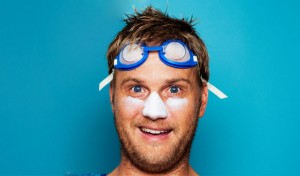
Often when we think of burn injuries, our minds jump to fire burns, electrical burns, etc. But how many of us forget about “simple”
sunburns? (Well, “simple” may be an understatement.)
Although the sun doesn’t seem too dangerous shining from light years away (or during the cold months of winter), ultraviolet rays can cause serious skin damage. UV rays can damage your skin even on cloudy days, through haze, or through fog and often lead to painful sunburns. Research shows that sunburns can even develop into life-threatening skin cancer later in life.
So what can you do to protect yourself? The following tips are from
The American Burn Association:
Skin & eye protection:
- Use liberal amounts of sunscreen with a Sun Protection Factor (SPF) of at least 15, even on cloudy days. Wear dark sunglasses to protect your eyes (even if you wear contacts with UV protection).
- Select shaded areas for outdoor activities, especially between 10:00 a.m. and 4:00 p.m. when the sun’s UV rays are the strongest.
- Wear a broad-brimmed hat, tightly woven clothing, and, where possible, a long-sleeved shirt (preferably cotton), and long pants when you spend long periods in the sun. If you’re wearing a baseball cap and plan to spend a lot of time outdoors, tuck a handkerchief under the back of the hat to prevent sunburn on your neck.
- Avoid tanning altogether. There is no safe way to tan. Damage to your skin from the sun and tanning beds can happen in just minutes of exposure to UV light. Tanning beds typically emit mostly deeper penetrating UVA rays, but some do emit UVB rays (which cause sunburns), too.
- Avoid using sunlamps
- Understand your medications. Certain prescriptions can make your skin more sensitive to UV rays. Consult your doctor with any questions about your medications.
- Infants have especially sensitive skin. And, unfortunately, they aren’t born with a skin protection system. They also can’t tell us if they are too hot or move on their own out of the sun, so it’s up to us to protect them.
How to protect your baby’s skin:
- Keep babies less than one years old out of direct sunlight to prevent skin damage and dehydration. Keep them in the shade under a tree, an umbrella, or a stroller canopy.
- Dress your baby in protective but loose clothing that will cover their skin: long pants, long-sleeved shirt, and a wide-brimmed hat.
- 15-30 minutes before going outside, apply PABA-free sunscreen with an SPF of at least 30,. Reapply every 2-3 hours, especially if children are playing in the water often. Do not apply sunscreen to babies under six months old.
- Make sure children have a water break every 30 minutes when they’re exercising or playing outdoors in high heat and humidity. Be sure kids drink plenty of water before, during, and after outside activity. If shade is available, insist on breaks to cool off for a few minutes every once in awhile.
- Don’t let infants or young children play or sleep in direct sun in a playpen, stroller, etc.
Sunscreen Tips:
When it comes to the sun, there are two types of UV rays that can harm your skin: UVB and UVA rays. UVB rays typically cause sunburns. UVA rays penetrate deeper into the skin and are associated with wrinkling, leathering, and other aspects of aging, not to mention skin cancer. It’s important to select the right type of sunscreen and to use it over and over again.
- Use a sunscreen with an SPF of at least 15 (which blocks about 94% of UVB rays). Make sure to choose a sunscreen that has both UVA UVB protection.
- Reapply ever 2-3 hours, as well as after swimming. No matter how strong the sunscreen is, it won’t last all day.
- Pay special attention to exposed areas such as the face, neck, ears, back, shoulders, knees, and tops of feet
- If applying multiple substances (i.e. bug repellant) on your skin, always put the sunscreen on first and wait 30 minutes before applying the other substances.
- No sunscreen provides 100% protection. Even after applying sunscreen, cover up with a hat, long-sleeve shirt, and pants.
Knowing how to keep yourself burn-free during the summer will allow you to enjoy the great outdoors without having to worry about treating an injury. If you do Replace yourself with a sun burn, don’t panic. Try using
Sunburn Rescue or
BurnFree. They help remove and evaporate the heat from your skin as well as provide some pain relief.
Check out our article “
First Aid for Burns” for more information about burn safety.
--Kim
Sources:
http://www.webmd.com/beauty/sun/high-spf-sunscreens-are-they-better
http://www.skincancer.org/prevention/sun-protection/sunscreen/sunscreens-explained
http://consults.blogs.nytimes.com/2009/06/03/is-there-such-a-thing-as-a-healthy-tan/?_php=true&_type=blogs&_r=0

